Chemical Kinetics
Question 1. For the reaction R → P. the concentration of a reactant changes from 0,03 M to 0.02 M in 25 minutes. Calculate the average rate of reaction using units of time both in minutes and seconds.
Answer:
Average rate of reaction = \(-\frac{\Delta[\mathrm{R}]}{\Delta \mathrm{t}}\)
⇒ \(-\frac{[R]_2-[R]_1}{t_2-t_1}=-\frac{0.02-0.03}{25} \mathrm{Mmin}^{-1}\)
⇒ \(-\frac{0.02-0.03}{25} \mathrm{Mmin}^{-1}\)
⇒ \(4 \times 10^{-4} \mathrm{M} \mathrm{Min}^{-1}\)
⇒ \(\frac{4 \times 10^{-4}}{60} \mathrm{Ms}^{-1}\)
⇒ \(6.67 \times 10^{-5} \mathrm{M} \mathrm{s}^{-1}\)
Question 2. In a reaction, 2A → Products, the concentration of A decreases from 0.5 mol L-1 to 0.4 mol L-1 in 10 minutes. Calculate the rate during this interval.
Answer:
⇒ \(-\frac{1}{2} \frac{\Delta[\mathrm{A}]}{\Delta t}=-\frac{1}{2} \frac{[\mathrm{A}]_2-[\mathrm{A}]_1}{\mathrm{t}_2-\mathrm{t}_1}\)
⇒ \(-\frac{1}{2} \frac{[0.4-0.5]}{10}=-\frac{1}{2} \frac{-0.1}{10}\)
⇒ 0.005 mol L-1 min-1 = 5 × 10-3 M min-1
Question 3. For a reaction, A + B → Product; the rate law is given by, r = K[ A]1/2[B]2 . What is the order of the reaction?
Answer:
The order of the reaction, \(\frac{1}{2}+2=2 \frac{1}{2}=2.5\)
Question 4. The conversion of molecules X to Y follows second-order kinetics. If the concentration of X is increased to three times how will it affect the rate of formation of Y?
Answer:
The order of reaction is defined as the sum of the powers of concentrations in the rate law.
The rate of second-order reaction can be expressed as rate = k[A]2
The reaction X → Y follows second-order kinetics.
Therefore, the rate equation for this reaction will be:
Rate = k [ X ]2
Let [X] = a mol L-1 . then equation (l) can be written as:
Rale = k [a]2 = ka2
If the concentration of X is increased to three times, then [X] = 3a mol L-1
Now, the rate equation will be ;
Rate = k [3a]2 = 9(ka2)
Hence, the rate of formation will increase by 9 times,
Read and Learn More Class 12 Chemistry with Answers Chapter Wise
Question 5. A first-order reaction has a rate constant of 1.15 × 10-3 S-1. How long will 5g of this reactant take to reduce to 3g?
Answer:
We know that for a 1st order reaction
⇒ \(t=\frac{2.303}{k} \log \frac{[R]_0}{[R]}=\frac{2.303}{1.15 \times 10^{-3}} \log \frac{5}{3}\)
⇒ \(\frac{2.303}{1.15 \times 10^{-3}} \times 0.2219=444.38 \mathrm{~s}=444 \mathrm{~s}\)

Question 6. The time required to decompose SO2Cl2 to half of its initial amount is 60 minutes. If decomposition is a first-order reaction, calculate the rate constant of the reaction.
Answer:
We know that fora 1st order reaction, \(t_{1 / 2}=\frac{0.693}{k}\)
It is given that t1/2 = 60 min
⇒ \(k=\frac{0.693}{t_{1 / 2}}=\frac{0.693}{60}=0.01155 \mathrm{~min}^{-1}=1.155 \times 10^{-2} \mathrm{~min}^{-1}\)
Question 7. What will be the effect of temperature on the rate constant?
Answer:
The rate constant of a reaction is nearly doubled with a 10°C rise in temperature. However, the exact dependence of the rate of a chemical reaction on temperature is given by the Arrhenius equation, k =Ae-Ea/RT
Where A is the Arrhenius factor or the frequency factor
T is the temperature
R is the gas constant
Ea is the activation energy
Question 8. The rate of the chemical reaction doubles for an increase of 10 K in an absolute temperature from 298 K. Calculate Ea.
Answer:
It is given that
T1 = 298 K
T2 = (298 + 10) K = 308 K
We also know that the rate of the reaction doubles when temperature is increased by 10°.
Therefore, let us take the value of k1= k and that k2 = 2k
Also, R = 8.314 JK-1 mol-1
Now, substituting these values in the equation:
⇒ \(\log \frac{k_2}{k_1}=\frac{E_a}{2.303 R}\left[\frac{T_2-T_1}{T_1 T_2}\right]\)
We get:
⇒ \(\log \frac{2 k}{k}=\frac{E_a}{2.303 \times 8.314}\left[\frac{10}{298 \times 308}\right] \Rightarrow \log 2=\frac{E_2}{2.303 \times 8.314}\left[\frac{10}{298 \times 308}\right]\)
⇒ \(E_a=\frac{2.303 \times 8.314 \times 298 \times 308 \times \log 2}{10}\)
⇒ 52897.78 J mol-1 = 52.9 kJ mol-1
Question 9. The activation energy for the reaction 2HIg → H2+ I2(g) is 209.5 kJ mol-1 at 581 K. Calculate the fraction of molecules of reactant having energy equal to or greater than the activation energy.
Answer:
The fraction of molecules of reactants having energy equal to or greater than activation energy is given as:
⇒ \(\mathrm{x}=\mathrm{e}^{-\mathrm{Ea} / \mathrm{RT}}\)
⇒ In x = -Ea/RT
⇒ \(\log x=\frac{-E_a}{2.303 R T}\)
⇒ \(\log x=\frac{209500 \mathrm{~J} \mathrm{~mol}^{-1}}{2.303 \times 8.314 \mathrm{JK}^{-1} \mathrm{~mol}^{-1} \times 581}=-18.8323\)
Now, x = Anti log (-18.8323)
= 1.471 × 10-19
Question 10. From the rate expression for the following reactions, determine their order of reaction and the dimensions of the rate constants.
Answer:
- 3NO(g) → N2O(g) ; Rate = k[NO]2
- H2O2(aq) + 31 (aq.) + H+ → 2H2O(I) + I–3 ; Rate = k[H2O)][I–]
- CH3CHO(g) → CH4(g) + CO(g) : Rate = k[CH3CHO]3/2
- C2H5Cl(g) → C2H2(g) + HCI(g) : Rate = k[C2H5Cl]
Answer:
Given rate = k[NO]2
Therefore, the order of the reaction = 2
Dimension of k = \(\frac{\text { Rate }}{[\mathrm{NO}]^2}=\frac{\mathrm{mol} \mathrm{L}^{-1} \mathrm{~s}^{-1}}{\left(\mathrm{~mol} \mathrm{~L}^{-1}\right)^2}=\frac{\mathrm{mol} \mathrm{L}^{-1} \mathrm{~s}^{-1}}{\mathrm{~mol}^{-2} \mathrm{~L}^{-2}}=\mathrm{L} \mathrm{mol}^{-1} \mathrm{~s}^{-1}\)
Give rate = k[H2O][I–]
Therefore, the order of the reaction = 2
Dimension of k = \(\frac{\text { Rate }}{\left[\mathrm{H}_2 \mathrm{O}_2\right]\left[\mathrm{I}^{-}\right]}=\frac{\mathrm{molL}^{-1} \mathrm{~s}^{-1}}{\left(\mathrm{molL}^{-1}\right)\left(\mathrm{molL}^{-1}\right)}=\mathrm{L} \mathrm{mol}^{-1} \mathrm{~s}^{-1}\)
Given rate = k[CHCHO]3/2
Therefore, order of reaction = \(\frac{3}{2}\)
⇒ \(\text { Dimension of } \mathrm{k}=\frac{\text { Rate }}{\left[\mathrm{CH}_3 \mathrm{CHO}\right]{\frac{3}{2}}}=\frac{\mathrm{mol} \mathrm{L}^{-1} \mathrm{~s}^{-1}}{\left(\mathrm{~mol} \mathrm{~L}^{-1}\right)^{\frac{3}{2}}}=\frac{\mathrm{mol} \mathrm{L}^{-1} \mathrm{~s}^{-1}}{\mathrm{~mol}^{\frac{3}{2}} \mathrm{~L}^{-\frac{3}{2}}}=\mathrm{L}^{\frac{1}{2}} \mathrm{~mol}^{-\frac{1}{2}} \mathrm{~s}^{-1}\)
Given rate- k[C2H5Cl]
Therefore, the order of the reaction = 1
⇒ \(\text { Dimension of } \mathrm{k}=\frac{\text { Rate }}{\left[\mathrm{C}_2 \mathrm{H}_5 \mathrm{Cl}\right]}=\frac{\mathrm{molL}^{-1} \mathrm{~s}^{-1}}{\mathrm{~mol} \mathrm{~L}^{-1}}=\mathrm{s}^{-1}\)
Question 11. For the reaction: 2A + B → A2B the rate = k [A][B]2 with k = 2.0 × 10-6 mol-2 L2S-1. Calculate the initial rate of the reaction when [A] = 0.1 mol L-1. [B] = 0.2 mol L-1. Calculate the rate of reaction after fAJ is reduced to 0.06 mol L-1.
Answer:
The initial rate of the reaction is Rate = k[A][B]2 = (2.0 × 10-6 mol-2 L2 S-1) (0.1 mol L-1) (0.2 mol L-1)2 = 8.0 × 10-9 mol -2 L2 s-1 when [A] is reduced from 0.1 mol L-1 to 0.06 mol-1, the concentration of A reacted = (0.1 -0.06) mol L-1 =0.04 mol L-1.
Therefore, concentration of B reacted \(=\frac{1}{2} \times 0.04 \mathrm{~mol} \mathrm{~L}^{-1}=0.02 \mathrm{~mol} \mathrm{~L}^{-1}\)
Then, a concentration of B is available. |B] = (0.2 – 0.02) mol L-1 = 0. 1 8 mol L-1 After [A] is reduced to 0.06 mol L-1. the rate of the reaction is given by.
Rate = k(A][B]2 = (2.0 × 10-6 mol-2 L2 s-1) (0.06 mol L-1) (0.18 mol L-1)2 = 3.88 × 10 mol L-1s-1.
Question 12. The decomposition of NH3, on the platinum surface is an order reaction. What is the rate of production of N2, and H2 if k = 2.5 × 10-4 mol liter s-1?
Answer:
2NH3 → N2 + 3H2
⇒ \(\text { Rate of reaction }(\mathrm{r})=-\frac{1}{2} \frac{\mathrm{d}\left[\mathrm{NH}_3\right]}{\mathrm{dt}}=\frac{\mathrm{d}\left[\mathrm{N}_2\right]}{\mathrm{dt}}=\frac{1}{3} \frac{\mathrm{d}\left[\mathrm{H}_2\right]}{\mathrm{dt}}\)
Rate (r) = k[NH3]° = k
(∵ zero order reaction)
= 2.5 × 10-4
⇒ \(\frac{\mathrm{d}\left[\mathrm{N}_2\right]}{\mathrm{dt}}=\mathrm{r}=2.5 \times 10^{-4} \mathrm{~mol} \mathrm{lit}^{-1} \mathrm{~s}^{-1}\)
⇒ \(\frac{\mathrm{d}\left[\mathrm{H}_2\right]}{\mathrm{dt}}=3 \mathrm{r}=3 \times 2.5 \times 10^{-4}=7.5 \times 10^{-4} \mathrm{~mol} \mathrm{lit}^{-1} \mathrm{sec}^{-1}\)
Question 13. The decomposition of dimethyl ether leads to the formation of CH4, H2, and CO, and the reaction rate is given by: Rate = k [ CH3OCH3]3/2 The rate of reaction is followed by an increase in pressure in a closed vessel, so the rate can also be expressed in terms of the partial pressure of dimethyl ether i.c., Rate = k[PCH3OCH3],3/2 If the pressure is measured in bar and time in minutes, then what are the units of rate and rate constants?
Answer:
⇒ \(\mathrm{CH}_3 \mathrm{OCH}_3 \longrightarrow \mathrm{CH}_4+\mathrm{CO}+\mathrm{H}_2\)
Rate = k(CH3OCH3]3/2; = k[P(CH3OCH3)]3/2
unit of rate = bar min-1
⇒ \(\text { Unit of } \mathrm{K}=\frac{\text { Rate }}{\left[\mathrm{P}_{\mathrm{CH}_3 \mathrm{OCH}_3}\right]^{3 / 2}}=\frac{\text { bar } \mathrm{min}^{-1}}{\text { bar }^{3 / 2}}=\mathrm{bar}^{-1 / 2} \mathrm{~min}^{-1}\)
Question 14. Mention the factors that affect the rate of a chemical reaction.
Answer:
The important factors on which the rate of a chemical reaction depends are
- Nature of the reacting species.
- Concentration of the reacting species.
- The temperature at which a reaction proceeds.
- The surface area of the reactants,
- Presence of a catalyst
Question 15. A reaction is of second order concerning a reactant. How is its rate affected if the concentration of the reactant is (1) doubled and (2) reduced to half?
Answer:
Given rate (r0 ) = K [A]2
If [A] is doubled: \(r_1=k[2 A]^2\)
r1 = 4r0
If [A] is reduced to half: \(\mathrm{r}_2=\mathrm{k}\left[\frac{\mathrm{A}}{2}\right]^2\)
⇒ \(r_2=\frac{1}{4} r_0\)
Question 16. What is the effect of temperature on the rate constant, of a reaction? How can this temperature effect on the rate constant be represented quantitatively?
Answer:
The rate constant is nearly doubled with a rise in temperature by 100C for a chemical reaction.
The temperature effect on the rate constant can be represented quantitatively by Arrhenius equation, k = Ac-Ea/RT
⇒ \(2.303 \log \frac{\mathrm{K}_2}{\mathrm{~K}_1}=\frac{\mathrm{E}_a}{\mathrm{R}}\left[\frac{\mathrm{T}_2-\mathrm{T}_1}{\mathrm{~T}_1 \mathrm{~T}_2}\right]\)
where K is the rate constant at the temperature
A is the Arrhenius parameter,
R is the gas constant,
T is the temperature,
and Ea is the energy of activation which is always positive.
Question 17. In a pseudo-first-order hydrolysis of ester in water, the following results were obtained:
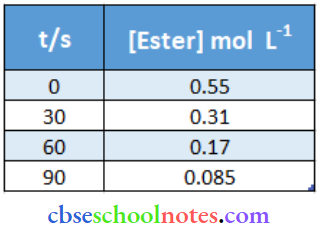
- Calculate the average rate of reaction between the time interval 30 to 60 seconds.
- Calculate the pseudo-first-order rate constant for the hydrolysis of ester.
Answer:
The average rate of reaction between the time interval 30 to 60 seconds
⇒ \(=\frac{\mathrm{d}[\text { Ester }]}{\mathrm{dt}}=-\frac{(0.17-0.31)}{60-30}=\frac{-(-0.14)}{30}=4.67 \times 10^{-3} \mathrm{~mol} \mathrm{~L}^{-1} \mathrm{~s}^{-1}\)
For a pseudo-first-order reaction.
⇒ \(\text { For } t=30 s, \quad k_1=\frac{2.303}{30} \log \frac{0.55}{0.31}=1.911 \times 10^{-2} \mathrm{~s}^{-1}\)
⇒ \(\text { For } \mathrm{t}=60 \mathrm{~s}, \quad \mathrm{k}_2=\frac{2.303}{60} \log \frac{0.55}{0.17}=1.957 \times 10^{-2} \mathrm{~s}^{-1}\)
⇒ \(\text { For } \mathrm{t}=90 \mathrm{~s}, \quad \mathrm{k}_3=\frac{2.303}{90} \log \frac{0.55}{0.85}=2.075 \times 10^{-2} \mathrm{~s}^{-1}\)
Then, average rate constant, k = \(\frac{k_1+k_2+k_3}{3}\)
⇒ \(=\frac{\left(1.911 \times 10^{-2}\right)+\left(1.957 \times 10^{-2}\right)+\left(2.075 \times 10^{-2}\right)}{3}=1.98 \times 10^{-2} \mathrm{~s}^{-1}\)
Question 18. A reaction is first order in A and second order in B:
- Write the differential rate equation.
- How is the rate affected when the concentration of B is tripled?
- How is the rate affected when the concentration of both A and B are doubled?
Answer:
Rate = k [A]1[B]2
r0= K[A]1[B]2
r1,= k [A]1[3 B]2
r1, = 9 × r0
r0 = K [A]1[B]2
r0 = k [2A]1[2B]2
r2 = – 8 × r0
Question 19. In a reaction between A and B the initial rate of reaction (r0) was measured for different initial concentrations A and B as given below:

What is the order of the reaction concerning A and B?
Answer:
Let the order of the reaction concerning A be x and B be y.
Therefore, r0 = k [A]x[B]y
5.07 x 10-5 =k [0.20]x[10.30]y _______ 1
5.07 x 10-5 = k [0.20]x[0.10]y _______ 2
1.43 x 10-4 = k [0.40]x[0.05]y _______ 3
Dividing equation (1) by (2), we obtain
⇒ \(\frac{5.07 \times 10^{-5}}{5.07 \times 10^{-5}}=\frac{\mathrm{k}[0.20]^{\mathrm{x}}[0.30]^y}{\mathrm{k}[0.20]^{\mathrm{x}}[0.10]^y}\)
⇒ \(I=\frac{[0.30]^y}{[0.10]^y}\)
⇒ \(\left(\frac{0.30}{0.10}\right)^0=\left(\frac{0.30}{0.10}\right)^y\)
⇒ y = 0
Dividing equation (3) by (1), we obtain
⇒ \(\frac{1.43 \times 10^{-4}}{5.07 \times 10^{-5}}=\frac{k[0.40]^x[0.05]^y}{k[0.20]^x[0.30]^y}\)
⇒ \(\frac{1.43 \times 10^{-4}}{5.07 \times 10^{-5}}=\frac{[0.40]^x}{[0.20]^x}\)
[Since y = 0 [0.05]y =[0.30] = 1]
⇒ 2.821 =2x
⇒ log 2.821 = x log 2 (Taking log on both sides)
⇒ \(x=\frac{\log 2.821}{\log 2}=1.496=1.5\)
Hence, the order of the reaction concerning A is 1.5, and concerning B is zero.
Question 20. The following results have been obtained during the kinetic studies of the reaction: 2A + B → C + D
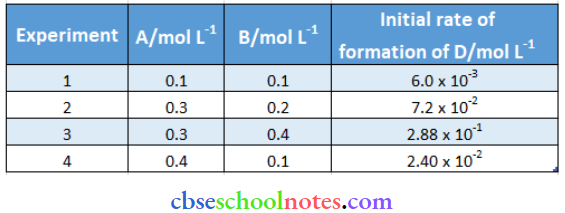
Determine the rate law and the rate constant for the reaction.
Answer:
Let the order of the reaction concerning A be x and for B be y.
Therefore, the rate of the reaction is given by,
Rate = k[A]x[B]y
According to the question.
6.0 × 10-3 = k[0.1]x [0.1]y
7.2 × 10-2 = k[0.3]x[0.2]y
2.88 × 10-1 = k[0.3]x [0.4]y
2.40 × 10-2 = k[0.4]x [0.1]y
Dividing equation (4) by (1), we obtain
⇒ \(\frac{2.4 \times 10^{-2}}{6.0 \times 10^{-3}}=\frac{k[0.4]^x[0.1]^y}{k[0.1]^x[0.1]^y}\)
⇒ \(4=\frac{[0.4]^x}{[0.1]^x} \Rightarrow 4=\left(\frac{0.4}{0.1}\right)^x \Rightarrow(4)^1=4^x \Rightarrow x=1\)
Dividing equation (3) by (2), we obtain
⇒ \(\frac{2.88 \times 10^{-1}}{7.2 \times 10^{-2}}=\frac{k[0.3]^x[0.4]^y}{k[0.3]^x[0.2]^y}\)
⇒ \(4=\left(\frac{0.4}{0.2}\right)^y \Rightarrow 4=2^y \Rightarrow 2^2=2^y \Rightarrow y=2\)
Therefore, the rate law is
⇒ \(\text { Rate }=k[A][B]^2 \Rightarrow k=\frac{\text { Rate }}{[A][B]^2}\)
From experiment I, we obtain
⇒ \(\mathrm{k}=\frac{6.0 \times 10^{-3} \mathrm{~mol} \mathrm{~L}^{-1} \mathrm{~min}^{-1}}{\left(0.1 \mathrm{~mol} \mathrm{~L}^{-1}\right)\left(0.1 \mathrm{~mol} \mathrm{~L}^{-1}\right)^2}=6.0 \mathrm{~L}^2 \mathrm{~mol}^{-2} \mathrm{~min}^{-1}\)
From experiment 2, we obtain
⇒ \(\mathrm{k}=\frac{7.2 \times 10^{-2} \mathrm{~mol} \mathrm{~L}^{-1} \mathrm{~min}^{-1}}{\left(0.3 \mathrm{~mol} \mathrm{~L}^{-1}\right)\left(0.2 \mathrm{~mol} \mathrm{~L}^{-1}\right)^2}=6.0 \mathrm{~L}^2 \mathrm{~mol}^{-2} \mathrm{~min}^{-1}\)
From exp. 3, we obtain,
⇒ \(\mathrm{k}=\frac{2.88 \times 10^{-1} \mathrm{~mol} \mathrm{~L}^{-1} \mathrm{~min}^{-1}}{\left(0.3 \mathrm{~mol} \mathrm{~L}^{-1}\right)\left(0.4 \mathrm{~mol} \mathrm{~L}^{-1}\right)^2}=6.0 \mathrm{~L}^2 \mathrm{~mol}^{-2} \mathrm{~min}^{-1}\)
From exp. 4, we obtain,
⇒ \(\mathrm{k}=\frac{2.40 \times 10^{-2} \mathrm{~mol} \mathrm{~L}^{-1} \mathrm{~min}^{-1}}{\left(0.4 \mathrm{~mol} \mathrm{~L}^{-1}\right)\left(0.1 \mathrm{~mol} \mathrm{~L}^{-1}\right)^2}=6.0 \mathrm{~L}^2 \mathrm{~mol}^{-2} \mathrm{~min}^{-1}\)
Therefore, the rate is constant.
k = 6.0 L2 mol-2 min-1.
Question 21. The reaction between A and B is first order concerning A and zero order concerning B. Fill in the blanks in the following table:
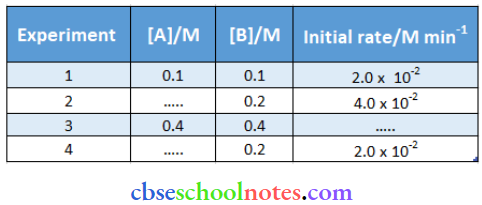
Answer:
The given reaction is of the first order concerning A and zero order concerning B.
Therefore, the rate of the reaction is given by.
Rate = k [A]1[B]0
Rate = k [A]
From experiment 1. we obtain
2.0 × 10-2 mol L-1 min-1 = k (0.1 mol L-1)
k = 0.2 min-1
From experiment 2. we obtain
4.0 x 10-2 mol L-1 min-1 = 0.2 min-1 [A]
[A] = [0.2] mol L-1
From experiment 3, we obtain
Rate = 0.2 min-1 x 0.4 mol L-1 = 0.08 mol L-1 min-1
From experiment 4, we obtain
2.0 x 10-2 mol L-1 mim-1 = 0.2 min-1 [A]
[A] = 0. 1 mol L-1
Question 22. Calculate the half-life of a first-order reaction from their rate constants given below:
- 200 s-1
- 2 min-1
- 4 year-1
⇒ \(t_{1 / 2}=\frac{0.693}{k}=\frac{0.693}{200 \mathrm{~min}^{-1}}=\mathbf{3 . 4} \times 10^{-3} \sec \text { (approx.) }\)
⇒ \(t_{1 / 2}=\frac{0.693}{k}=\frac{0.693}{2 \mathrm{~min}^{-1}}=\mathbf{0 . 3 5} \mathbf{~ m i n} \text { (approx.) }\)
⇒ \(t_{1 / 2}=\frac{0.693}{k}=\frac{0.693}{4 \text { year }^{-1}}=1.733 \times 10^{-1} \text { years (approx.) }\)
Question 23. The half-life for radioactive decay of 14C is 5730 years. An archaeological artifact containing wood had only 80% of the 14C found in a living tree. Estimate the age of the sample.
Answer:
Here, \(k=\frac{0.693}{t_2}=\frac{0.693}{5730} \text { years }^{-1}\)
⇒ \(t=\frac{2.303}{k} \log \frac{a}{(a-x)}\)
⇒ \(\mathrm{t}_{1 / 2} \text { of }{ }^{14} \mathrm{C}=5730 \mathrm{yr} \text {; }\)
Also, a = 1 00, (a – x) = 80
⇒ \(\mathrm{t}=\frac{2.303 \times 5730}{0.693} \log \frac{100}{80}=1845 \mathrm{yr} \)
Question 24. The experimental data for the decomposition of N2O3
⇒ \(\left[2 \mathrm{~N}_2 \mathrm{O}_5 \longrightarrow 4 \mathrm{NO}_2+\mathrm{O}_2\right]\) in the gas phase at 3 18 K are given below:

- Plot [N2O5] against t.
- Find the half-life period for the reaction.
- Draw a graph between log [N2O5] and t.
- What is the rate law?
- Calculate the rate constant.
- Calculate the half-life period from k and compare it with (2).
Answer:
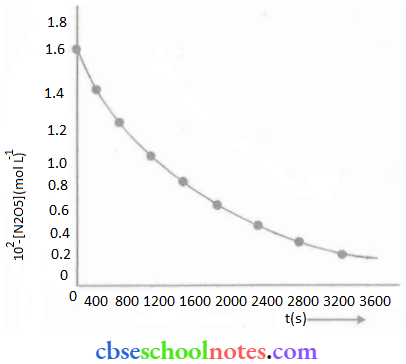
Time corresponding to the concentration, \(\frac{1.630 \times 10^2}{2} \mathrm{molL}^{-1}=81.5 \mathrm{~mol} \mathrm{~L}^{-1}\) is the half life. From the graph, the half-life is obtained as 1450 s.

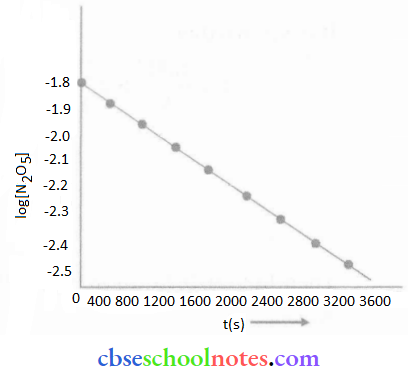
The given reaction of the first order as the plot, log [N2O5] v/s t, is a straight line. Therefore, the rate law of the reaction is
Rate= k [N2O5]
From the plot, log [N2O5] v/st, we obtain
⇒ \(\text { Slope }=\frac{-2.46-(-1.79)}{3200-0}=\frac{-0.67}{3200}\)
Again .slope of the line of the plot log [N,05] v/s t is given by \(-\frac{k}{2.303}\)
Therefore, we obtain,
⇒ \(-\frac{k}{2.303}=-\frac{0.67}{3200}\)
k = 4.82 × 10-4,s-1
Half-life is given by,
⇒ \(t_{1 / 2}=\frac{0.639}{k}=\frac{0.693}{4.82 \times 10^{-4}} \mathrm{~s}\)
⇒ 1.438 x 10%- 1438s
This value, 1438 s. is very close to the value that was obtained from the graph.
Question 25. The rate constant for a first-order reaction is 60 s-1 How much time will it take to reduce the initial concentration of the reactant to its 1/16th value?
Answer:
It is known that,
⇒ \(t=\frac{2.303}{k} \log \frac{a}{(a-x)}\)
⇒ \(\text { If } a=1 \text { then }(a-x)=\frac{1}{16}\)
⇒ \(\mathrm{t}=\frac{2.303}{60 \mathrm{~s}^{-1}} \log \frac{1}{1 / 16}=\mathbf{0 . 0 4 6 2} \mathrm{s}\)
Question 26. During a nuclear explosion, one of the products is 90Sr with a half-life of 28.1 years. If I pg of 90Sr was absorbed in the bones of a newborn baby instead of calcium, how much of it will remain after 10 years and 60 years if it is not lost metabolically?
Answer:
Here, \(k=\frac{0.693}{t_{1 / 2}}=\frac{0.693}{28.1} y^{-1}\)
It is known that,
⇒ \(t=\frac{2.303}{k} \log \frac{[R]_0}{[R]} \quad \Rightarrow 10=\frac{2.303}{\frac{0.693}{28.1}} \log \frac{1}{[R]} \Rightarrow 10=\frac{2.303}{\frac{0.693}{28.1}}(-\log [R])\)
⇒ \(\log [R]=-\frac{10 \times 0.693}{2.303 \times 28.1} \Rightarrow[R]=\text { anti } \log (-0.1071)\)
= anti log(T.8929) = 0.74814 μg
Therefore, 0.7814 μg of 90Sr will remain after 10 years,
Again,
⇒ \(t=\frac{2.303}{k} \log \frac{[R]_0}{[R]} \Rightarrow 60=\frac{2.303}{\frac{0.693}{28.1}} \log \frac{1}{[R]} \Rightarrow \log [R]=-\frac{60 \times 0.693}{2.303 \times 28.1}\)
[R] = antilog (-0.6425) = 0.2278 μg
Therefore, 0.2278 μg of 90Sr will remain after 60 years.
Question 27. For a first-order reaction, show that the time required for 99% completion is twice the time required for the completion of 90% of the reaction.
Answer:
For a first-order reaction, the time required for 99% completion is
⇒ \(t_1=\frac{2.303}{k} \log \frac{100}{100-99}=\frac{2.303}{k} \log 100=2 \times \frac{2.303}{k}\)
For a first-order reaction, the time required for 90% completion is
⇒ \(t_2=\frac{2.303}{k} \log \frac{100}{100-90}=\frac{2.303}{k} \log 10=\frac{2.303}{k}\)
Therefore, t1 = 2t2
Hence, the time required for 99% completion of a first-order reaction is twice the time required for the completion of 90% of the reaction.
Question 28. A first-order reaction takes 40 min for 30% decomposition. Calculate t1/2.
Answer:
For a first-order reaction,
⇒ \(t=\frac{2.303}{k} \log \frac{[R]_0}{[R]}\)
⇒ \(\mathrm{k}=\frac{2.303}{40 \mathrm{~min}} \log \frac{100}{100-30}=\frac{2.303}{40 \mathrm{~min}} \log \frac{10}{7}=8.918 \times 10^{-3} \mathrm{~min}^{-1}\)
Therefore. t1/2 of the decomposition reaction is
⇒ \(t_{1 / 2}=\frac{0.693}{k}=\frac{0.693}{8.918 \times 10^{-3}} \min =77.7 \mathrm{~min} \text { (approx.) }\)
Question 29. For the decomposition of azoisopropane to hexane and nitrogen at 543 K, the following data are obtained.

Calculate the rate constant.
Answer:
The decomposition of azoisopropane to hexane and nitrogen at 543 K is represented by the following equation.
(CH3)2 CHN = NCH (CH3)2(g → N2(g) + C6H14(g)
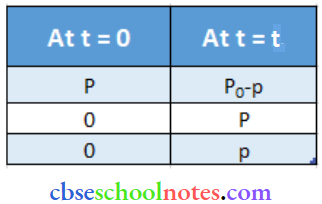
After time, t, total pressure, Pt = (P0– p) + p + p
Pt = P0+p
⇒ p = Pt-P0
Therefore, P0 – p = P0 (Pt – P0) = 2P0 – P1.
For a first-order reaction,
⇒ \(k=\frac{2.303}{t} \log \frac{P_0}{P_0-x}=\frac{2.303}{t} \log \frac{P_0}{2 P_0-P_t}\)
When t = 360 s,
⇒ \(\mathrm{k}=\frac{2.303}{360 \mathrm{~s}} \log \frac{35.0}{(2 \times 35.0-54.0)}=2.175 \times 10^{-3} \mathrm{~s}^{-1}\)
When t = 720 s,
⇒ \(\mathrm{k}=\frac{2.303}{720 \mathrm{~s}} \log \frac{35.0}{2 \times 35.0-63.0}=2.235 \times 10^{-3} \mathrm{~s}^{-1}\)
Hence, the average value of the rate constant is
⇒ \(\mathrm{k}=\frac{\left(2.175 \times 10^{-3}\right)+\left(2.235 \times 10^{-3}\right)}{2} \mathrm{~s}^{-1}=2.205 \times 10^{-3} \mathrm{~s}^{-1}\)
Question 30. The following data were obtained during the first-order thermal decomposition of SO2Cl2, at a constant volume.
⇒ \(\mathrm{SO}_2 \mathrm{Cl}_2(\mathrm{~g}) \longrightarrow \mathrm{SO}_2(\mathrm{~g})+\mathrm{Cl}_2(\mathrm{~g})\)
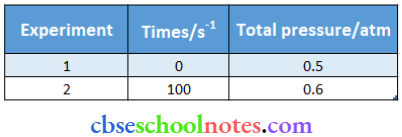
Calculate the rate of the reaction when the total pressure is 0.65 atm.
Answer:
The thermal decomposition of SO2Cl2, at a constant volume, is represented by the following equation.
⇒\(\mathrm{SO}_2 \mathrm{Cl}_2(\mathrm{~g}) \longrightarrow \mathrm{SO}_2(\mathrm{~g})+\mathrm{Cl}_2(\mathrm{~g})\)
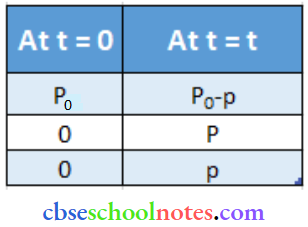
After time, t, total pressure, P, = (P0- p) + p + p
⇒ P1 = P0+P
⇒ P = P1-P0
Therefore, P0– p = P0– (Pt – P2) = 2P0– P1,
For a first-order reaction,
⇒ \(\mathrm{k}=\frac{2.303}{\mathrm{t}} \log \frac{\mathrm{P}_0}{\mathrm{P}_0-\mathrm{x}}=\frac{2.303}{\mathrm{t}} \log \frac{\mathrm{P}_0}{2 \mathrm{P}_0-\mathrm{P}_{\mathrm{t}}}\)
When t = 100 s, \(\mathrm{k}=\frac{2.303}{100 \mathrm{~s}} \log \frac{0.5}{2 \times 0.5-0.6}=2.231 \times 10^{-3} \mathrm{~s}^{-1}\)
When Pt = 0.65 atm, P0 + p- 0.65
p = 0.65- P0 = 0.65- 0.5 = 0. 15 atm
Therefore, when the total pressure is 0.65 atm, the Pressure of SOCl2
PSO2Cl2= P0– P = 0-5 – 0.15 = 0.35 atm
Therefore, the rate of equation, when total pressure is 0.65 atm, is given by,
Rate = k (pSO2Cl2) = (2.23 × 10-3 s-1 ) (0.35 atm) = 7.8 × 10-4 atm s-1
Question 31. The rate constant for the decomposition of N2O5 at various temperatures is given below:

Draw a graph between In k and 1/T and calculate the values of A and Ea. Predict the rate constant at 30° and 50°C.
Answer:
For the given data, we obtain
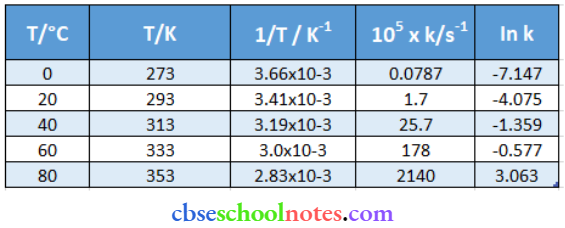

The slope of the line.
⇒ \(\frac{y_2-y_1}{x_2-x_1}=12.301 K\)
According to Arrhenius’s equations. Slope = \(-\frac{E_a}{R}\)
⇒ \(\mathrm{E}_{\mathrm{a}}=- \text { Slope } \times \mathrm{R}=-(-12.301 \mathrm{~K}) \times\left(8.314 \mathrm{JK}^{-1} \mathrm{~mol}^{-1}\right)=102.27 \mathrm{~kJ} \mathrm{~mol}^{-1}\)
Again, In k = In \(A-\frac{E_a}{R T}\)
In A = In \(k+\frac{E_a}{R T}\)
When T = 273 K,
In k =-7,147
Then, In A = \(-7.147+\frac{102.27 \times 10^3}{8.314 \times 273}=37.911\)
Therefore, A = 2.91 x 1016
When T = 30 + 273 K = 303 K
⇒ \(\frac{1}{\mathrm{~T}}=0.0033 \mathrm{~K}=3.3 \times 10^{-3} \mathrm{~K}\)
Then, at \(\frac{1}{\mathrm{~T}}=3.3 \times 10^{-3} \mathrm{~K} \text {,}\)
In k = -2.8
Therefore, k = 6.08 x 10~2 s-1
Again, when T = 50 + 273 K = 323 K.
⇒ \(\frac{1}{\mathrm{~T}}=0.0031 \mathrm{~K}=3.1 \times 10^{-3} \mathrm{~K}\)
Then, at \(\frac{1}{\mathrm{~T}}=3.1 \times 10^{-3} \mathrm{~K} \text {, }\)
In k = -0.968
Therefore, k = 0.38s-1
Question 32. The rate constant for the decomposition of hydrocarbons is 2.418 x 10-5 s-1 at 546 K. If the energy of activation is 179.9 KJ/mol, what will be the value of the pre-exponential factor?
Answer:
According to the Arrhenius equation,
⇒ \(\mathrm{k}=\mathrm{Ae}^{-\mathrm{E}_{\mathrm{a}} / \mathrm{RT}} \Rightarrow{In} \mathrm{k}={In} \mathrm{A}-\frac{\mathrm{E}_{\mathrm{a}}}{\mathrm{RT}}\)
⇒ \(\log \mathrm{k}=\log \mathrm{A}-\frac{\mathrm{E}_{\mathrm{a}}}{2.303 \mathrm{R} T}\)
⇒ \(\log \mathrm{A}=\log \mathrm{k}+\frac{\mathrm{E}_{\mathrm{a}}}{2.303 \mathrm{RT}}\)
⇒ \(=\log \left(2.418 \times 10^{-5} \mathrm{~s}^{-1}\right)+\frac{179.9 \times 10^3 \mathrm{~J} \mathrm{~mol}^{-1}}{2.303 \times 8.314 \mathrm{Jk}^{-1} \mathrm{~mol}^{-1} \times 546 \mathrm{~K}}\)
= (0.3855 – 5) + 1 7.2082 = 12,59 17
Therefore, A = antilog ( 12.5917) = 3.9 x 1012 s-1
Question 33. Consider a certain reaction A → Products with k = 2.0 x 10-2 s -1. Calculate the concentration of A remaining after 100s if the initial concentration of A is 1.0 mol L-1.
Answer:
Since the unit of k is s-1. the given reaction is a first-order reaction.
Therefore, \(k=\frac{2.303}{t} \log \frac{[\mathrm{A}]_0}{[\mathrm{~A}]}\)
⇒ \(2.0 \times 10^{-2} \mathrm{~s}^{-1}=\frac{2.303}{100 \mathrm{~s}} \log \frac{1.0}{[\mathrm{~A}]}\)
⇒ \(2.0 \times 10^{-2} \mathrm{~s}^{-1}=\frac{2.303}{100 \mathrm{~s}}(-\log [\mathrm{A}])\)
⇒ \(\log [A]=\frac{-2.0 \times 10^{-2} \times 100}{2.303}\)
⇒ \([A]={anti} \log \left(\frac{-2.0 \times 10^{-2} \times 100}{2.303}\right)=0.135 \mathrm{~mol} \mathrm{~L}^{-1}\)
Hence, the remaining concentration of A is 0,135 mol L-1.
Question 34. Sucrose decomposes in acid solution into glucose and fructose according to the first order rate law, with t1/2 = 3,00 hours. What fraction of the sample of sucrose remains after 8 hours?
Answer:
For a first order reaction, k = \(\frac{2.303}{t} \log \frac{[R]_0}{[R]}\)
It is given that, t1/2 = 3.00 hours
Therefore, k = \(\frac{0.693}{t_{1 / 2}}=\frac{0.693}{3} h^{-1}=0.231 h^{-1}\)
Then, \(0.231 \mathrm{~h}^{-1}=\frac{2.303}{8 \mathrm{~h}} \log \frac{[\mathrm{R}]_0}{[\mathrm{R}]}\)
⇒ \(\log \frac{[\mathrm{R}]_0}{[\mathrm{R}]}=\frac{0.23 \mathrm{Ih}^{-1} \times 8 \mathrm{~h}}{2.303}\)
⇒ \(\frac{[R]_0}{|R|}={anti} \log (0.8024)\)
⇒ \(\frac{[\mathrm{R}]_0}{[\mathrm{R}]}=6.3445\)
⇒ \(\frac{[\mathrm{R}]}{[\mathrm{R}]_0}=0.1576 \approx 0.158\)
Hence, the fraction of the sample of sucrose that remains after 8 hours is 0.158.
Question 35. The decomposition of hydrocarbon follows the equation k = (4.5 ¹ 1011 s-1) e-28000 K/T. Calculate E,
Answer:
The given equation is k = (4.5 × 1011 s-1) e-28000 K/T ______ 1
Arrhenius equation is given by, k – Ae-Ea/RT ______ 2
From equation (1) and (2). we obtain
⇒ \(\frac{E_a}{R T}=\frac{28000}{T}\)
E2 = R × 28000 K = 8.3141 K-1 mol-1 × 28000 K = 2327921 J mol-1 = 232.792 kJ mol-1
Question 36. The following equation gives the rate constant for the first-order decomposition of H2O2: log k = 14.34- 1.25 × 104 K/T. Calculate E for this reaction and at what temperature will its half-period be 256 minutes?
Answer:
Arrhenius equation is given by.
⇒ \(\mathrm{k}=\mathrm{Ae}^{-\mathrm{E}_a / \mathrm{RT}}\)
⇒ \(\text { In } k={In} A-\frac{E_a}{R T}\)
⇒ \(\log \mathrm{k}=\log \mathrm{A}-\frac{\mathrm{E}_{\mathrm{a}}}{2.303 \mathrm{RT}}\) ______ 1
The given equation is, log k = 14.34 – 1.23 x 104 K/T _______ 2
From equation (1) and (2), we obtain
⇒ \(\frac{\mathrm{E}_{\mathrm{i}}}{2.303 \mathrm{RT}}=\frac{1.25 \times 10^4 \mathrm{~K}}{\mathrm{~T}}\)
Ea = 1 .25 x 1 04 K × 2.303 xR = 1 .25 × 104 K × 2.303 × 8.314 K-1 mol-1
= 239339.3 J mol-1 = 239.34 kJ mol-1
Also, when t1/2= 256 minutes,
⇒ \(\mathrm{k}=\frac{0.693}{\mathrm{t}_{1 / 2}}=\frac{0.693}{256}=2.707 \times 10^{-3} \mathrm{~min}^{-1}=4.51 \times 10^{-5} \mathrm{~s}^{-1}\)
It is also given that, log k = 14.34- 1.25 x 104 K/T
⇒ \(\log \left(4.51 \times 10^{-5}\right)=14.34-\frac{1.25 \times 10^4}{T}\)
⇒ \(0.654-5=14.34-\frac{1.25 \times 10^4 \mathrm{~K}}{\mathrm{~T}}\)
⇒ \(\frac{1.25 \times 10^4 \mathrm{~K}}{\mathrm{~T}}=18.686\)
⇒ \(\mathrm{T}=\frac{1.25 \times 10^4 \mathrm{~K}}{18.686}=668.95 \mathrm{~K}=669 \mathrm{~K}\)
Question 37. The decomposition of A into product has a value of k as 4.5 x 103s_1 at 10°C and energy of activation 60 kJ mol-1. At what temperature would k be 1.5 x 104 s-1?
Answer:
From Arrhenius equation, we obtain,
⇒ \(\log \frac{k_2}{k_1}=\frac{E_a}{2.303 R}\left(\frac{T_2-T_1}{T_1 T_2}\right)\)
⇒ \(\log \frac{1.5 \times 10^4}{4.5 \times 10^3}=\frac{6.0 \times 10^4 \mathrm{~J} \mathrm{~mol}^{-1}}{2.303 \times 8.314 \mathrm{JK}^{-1} \mathrm{~mol}^{-1}}\left(\frac{\mathrm{T}_2-283}{283 \mathrm{~T}_2}\right)\)
⇒ \(0.5229=3133.627\left(\frac{\mathrm{T}_2-283}{283 \mathrm{~T}_2}\right)\)
⇒ \(\frac{0.5229 \times 283 \mathrm{~T}_2}{3133.627}=\mathrm{T}_2-283\)
⇒ 0.9528 T2 = 283
⇒ T2 = 297.019 K = 297 K = 24° C
Hence, k would be 1.5 x 104 s-1 at 24° C
Question 38. The time required for 10% completion of a first-order reaction at 298K is equal to that required for its 25% completion at 308 K. If the value of A is 4 x 1010 s-1. Calculate k at 318 K and F.
Answer:
For a first-order reaction, \(t=\frac{2.303}{k} \log \frac{a}{a-x}\)
⇒ \(\text { At } 298 \mathrm{~K}, \mathrm{t}_1=\frac{2.303}{k_1} \log \frac{100}{90}=\frac{0.1054}{k_1}\)
⇒ \(\text { At } 308 \mathrm{~K}, \mathrm{t}_2=\frac{2.303}{\mathrm{k}_2} \log \frac{100}{75}=\frac{0.2877}{\mathrm{k}_2}\)
According to the question, t = t’
⇒ \(\frac{0.1054}{k_1}=\frac{0.2877}{k_2} \Rightarrow \frac{k_2}{k_1}=2.73\)
From the Arrhenius equation, we obtain
⇒ \(\log \frac{k_2}{k_1}=\frac{E_1}{2.303 R}\left(\frac{T_2-T_1}{T_1 T_2}\right)\)
⇒ \(\log (2.73)=\frac{E_a}{2.303 \times 8.314}\left(\frac{308-298}{298 \times 308}\right)\)
⇒ \(\mathrm{E}_{\mathrm{a}}=\frac{2.303 \times 8.314 \times 298 \times 308 \times \log (2.73)}{308-298}\)
⇒ 76640.26 J mol-1 = 76.64 Id mol-1
To calculate k at 318 K,
It is given that, A = 4 x 10-1 s-1, T = 318 K
Again, from the Arrhenius equation, we obtain
⇒ \(\log \mathrm{k}=\log \mathrm{A}-\frac{\mathrm{E}_{\mathrm{a}}}{2.303 \mathrm{R} T}=\log \left(4 \times 10^{10}\right)-\frac{76.6 \times 10^3}{2.303 \times 8.3\lceil 4 \times 318}\)
= (0.6021 + 10)- 12.5876 =- 1.9855
Therefore, k = Antilog (- 1.9855) = 1.05 x 10-1 s-1
Question 39. The rate of a reaction quadruples when the temperature changes from 293 K to 313 K. Calculate the energy of activation of the reaction assuming that it does not change with temperature.
Answer:
From Arrhenius equation, we obtain,
⇒ \(\log \frac{k_2}{k_1}=\frac{E_a}{2.303 R}\left(\frac{T_2-T_1}{T_1 T_2}\right)\)
It is given that, k2 = 4k1
T1 = 293 K: T2 = 313 K
Therefore, \(\log \frac{4 k_1}{k_1}=\frac{E_a}{2.303 \times 8.314}\left(\frac{313-293}{293 \times 313}\right)\)
⇒ \(0.6021=\frac{20 \times E_a}{2.303 \times 8.314 \times 293 \times 313}\)
⇒ \(\mathrm{E}_{\mathrm{a}}=\frac{0.6021 \times 2.303 \times 8.314 \times 293 \times 313}{20}\)
⇒ 52863.33 J mol-1 = 52.86 kJ mol-1
Hence, the required energy of activation is 52.86 kJ mol-1
